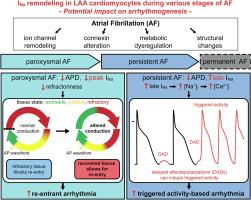Differential Sodium Current Remodelling Identifies Distinct Cellular Proarrhythmic Mechanisms in Paroxysmal vs Persistent Atrial Fibrillation |
| |
| Affiliation: | 1. Amsterdam UMC, location University of Amsterdam, Department of Experimental Cardiology, Amsterdam Cardiovascular Sciences, Heart failure & Arrhythmias, Amsterdam, The Netherlands;2. Amsterdam UMC, location University of Amsterdam, Department of Cardiology, Amsterdam Cardiovascular Sciences, Heart failure & Arrhythmias, Amsterdam, The Netherlands;3. Amsterdam UMC, location University of Amsterdam, Department of Medical Biology, Amsterdam Cardiovascular Sciences, Heart failure & Arrhythmias, Amsterdam, The Netherlands |
| |
| Abstract: | 
BackgroundThe cellular mechanisms underlying progression from paroxysmal to persistent atrial fibrillation (AF) are not fully understood, but alterations in (late) sodium current (INa) have been proposed. Human studies investigating electrophysiological changes at the paroxysmal stage of AF are sparse, with the majority employing right atrial appendage cardiomyocytes (CMs). We here investigated action potential (AP) characteristics and (late) INa remodelling in left atrial appendage CMs (LAA-CMs) from patients with paroxysmal and persistent AF and patients in sinus rhythm (SR), as well as the potential contribution of the “neuronal” sodium channel SCN10A/NaV1.8.MethodsPeak INa, late INa and AP properties were investigated through patch-clamp analysis on single LAA-CMs, whereas quantitative polymerase chain reaction was used to assess SCN5A/SCN10A expression levels in LAA tissue.ResultsIn paroxysmal and persistent AF LAA-CMs, AP duration was shorter than in SR LAA-CMs. Compared with SR, peak INa and SCN5A expression were significantly decreased in paroxysmal AF, whereas they were restored to SR levels in persistent AF. Conversely, although late INa was unchanged in paroxysmal AF compared with SR, it was significantly increased in persistent AF. Peak or late Nav1.8-based INa was not detected in persistent AF LAA-CMs. Similarly, expression of SCN10A was not observed in LAAs at any stage.ConclusionsOur findings demonstrate differences in (late) INa remodeling in LAA-CMs from patients with paroxysmal vs persistent AF, indicating distinct cellular proarrhythmic mechanisms in different AF forms. These observations are of particular relevance when considering potential pharmacologic approaches targeting (late) INa in AF. |
| |
| Keywords: | |
| 本文献已被 ScienceDirect 等数据库收录! |
|

